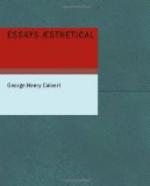In Asia, too, a chosen people early made a revelation of the beautiful. The Hebrews were introspective. At once ardent and thoughtful, passionate and spiritual, their vigorous natures were charged with fiery materials for inward conflicts. Out of the secret chambers of troubled souls their poets and prophets sent forth cries of despair and of exultation, of expostulation and self-reproach, that ever find an echo in the conscience-smitten, sorrow-laden bosom of man. The power and wisdom of God they saw as no other ancient people had seen them. In the grandeurs and wonders of creation they could behold the being and the might and the goodness of the Creator. The strong, rich hearts of their seers yearned for a diviner life, in the deep, true consciousness they felt that there can be peace and joy to man only through reconcilement with God. And feeling their own unworthiness and impurity, as well as that of their people, they uttered their spiritual desires, and their aspirations and disappointments and indignations and humiliations, in strains that make their great writings sound like one long, impassioned, rhythmic wail through the bars of a dungeon. Gloomy, wrathful, and intense, their utterances are grand and pathetic and sublime; but the beautiful plays through them, and gilds their highest points as the white crests do the billows of a black, tempestuous sea.
Save these two, no other nations of antiquity, except the Hindoos, seem to have had more than a superficial susceptibility to the beautiful. The Romans learnt the arts from the Greeks, whom they imitated, at a wide distance, in poetry as well as in sculpture and architecture. The remnants of art found in the valley of the Nile prove the Egyptians to have had the germ without the vitality to unfold it. In the literature of the Hindoos there are currents of pure poetry and of biblical depth. In passing down from ancient to modern times the Persians and the Arabians light the long way with scintillations from the beautiful.
The ugly semi-barbarian darkness of the Middle Ages in Europe was first broken by the light that shone from the spires of Gothic cathedrals in the eleventh century. About the twelfth century the German mind was further illuminated by that mysterious, visionary, titanic, Teutonic epic, the Niebelungen Lied; and a little later appeared the troubadours in the south of Europe and the minnesingers (love-singers) in Germany. Next came Dante and Giotto in Italy, then Chaucer in England; so that by the end of the fourteenth century,




